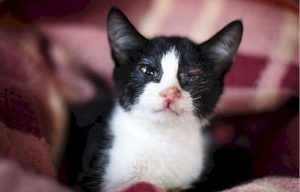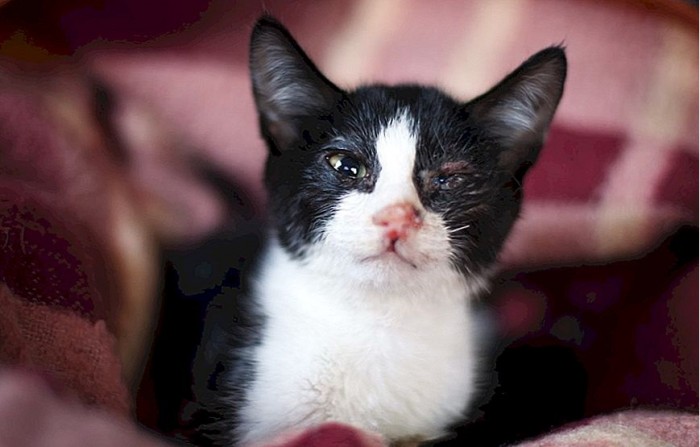Cats are wonderful companions, but just like humans, they can experience health issues too. One common problem that cats may encounter is conjunctivitis, which refers to the inflammation of the conjunctiva. In this article, we will explore the causes, symptoms, and treatments for cat conjunctivitis, providing you with valuable insights on how to care for your feline friend.

Table of Contents
Understanding Conjunctivitis
Conjunctivitis is a condition characterized by the inflammation of the conjunctiva, a mucous membrane that covers the white part of the eyeball and lines the inner eyelids of cats. This membrane is similar to the lining of the mouth and nose. Normally, the conjunctiva has a pale pink color and is not readily visible in healthy cats.
Clinical Signs of Conjunctivitis
If your cat is suffering from conjunctivitis, you may notice several clinical signs. Excessive tearing or watering from one or both eyes, abnormal discharge (cloudy, yellow, or greenish), and reddened conjunctival membranes are common indications of conjunctivitis in cats. Additionally, your cat may squint or keep their eyes closed due to discomfort or sensitivity to bright light (photophobia). In severe cases, the conjunctival tissue or the third eyelid may become swollen, partially or fully covering the eye. If you observe any of these signs, it is crucial to seek immediate veterinary examination for your cat.
Causes of Conjunctivitis
Conjunctivitis in cats can be caused by various factors, which can be broadly categorized into infectious and non-infectious causes. Additionally, conjunctivitis can also be a secondary symptom of another eye disease.
Infectious Causes of Conjunctivitis
Infectious agents such as bacteria, viruses, and fungi are the primary culprits behind conjunctivitis in cats. Viruses like feline viral rhinotracheitis (FVR), feline herpesvirus, and feline calicivirus often initiate the inflammation. Secondary infections with bacteria, including Streptococci and Staphylococci, commonly complicate primary viral infections. Other bacteria such as Chlamydophila felis and Mycoplasma can also cause primary conjunctivitis. These infectious diseases may lead to corneal inflammation (keratitis) and ulceration.
Non-infectious Causes of Conjunctivitis
Certain breeds, such as Persians, Himalayans, and other long-haired cats, may be born with a condition called entropion, where the eyelids turn inward. This condition causes corneal irritation as the eyelashes constantly rub against the eyeball. Foreign material, including dirt, sand, and plant material, can become trapped inside the eyelids, leading to conjunctivitis. Exposure to irritant chemicals is also known to initiate conjunctivitis. Allergies are believed to be a common cause of conjunctivitis, although identifying and avoiding specific allergens can be challenging. Additionally, conjunctivitis can be a symptom of eye and eyelid tumors, corneal ulcers or injuries, dry eye (keratoconjunctivitis sicca or “KCS”), glaucoma, and uveitis.
Diagnosing Conjunctivitis
To diagnose conjunctivitis in cats, your veterinarian will take a thorough medical history and perform a comprehensive examination of your cat’s eyes and surrounding tissues. An ophthalmoscope, a specialized device, may be used to examine the eyes more closely. Your veterinarian will look for foreign material, corneal ulcers or injuries, entropion, and tumors. Specific tests may be conducted based on the examination and history. Tear production and intraocular pressure (pressure inside the eyes) may be measured. Fluorescein dye can be used to detect underlying corneal injuries or ulcers. Conjunctival scrapings or biopsies may be obtained and sent for specialized laboratory testing. Nasolacrimal or tear duct flushing may be performed to ensure proper drainage. Blood tests may be necessary to identify if the conjunctivitis is related to a systemic condition. If no other cause is found, treatment is often initiated based on a tentative diagnosis of non-specific infectious conjunctivitis. Further testing is conducted if the condition does not improve or if other pets are at risk of infection.
Treatment Options
The treatment of conjunctivitis in cats depends on the specific diagnosis. In cases of non-specific infectious conjunctivitis, eye medications containing a combination of broad-spectrum antibiotics and anti-inflammatory drugs are commonly used. These medications can be in the form of drops or ointments. Local treatment may be complemented with injections or pills. Let’s explore the treatment options for different types of conjunctivitis:
Non-specific Infectious Conjunctivitis
For non-specific infectious conjunctivitis, the general approach is to use eye medications that contain broad-spectrum antibiotics to control primary or secondary bacterial infections and anti-inflammatory drugs to reduce inflammation. These medications are available as drops or ointments. In some cases, additional injections or oral medications may be required for effective treatment. It is essential to follow the prescribed treatment regimen and apply the medications as instructed by your veterinarian.
Herpesvirus Conjunctivitis
Herpesvirus infections usually resolve on their own without treatment. However, infected cats may remain carriers of the virus and experience intermittent relapses. Antibiotics are often prescribed to treat secondary bacterial infections. In severe or unresponsive cases, antiviral medications may be used. L-lysine, an amino acid, is believed to accelerate healing and reduce recurrences, although scientific studies have not shown significant benefits. Interferon-alpha, an immune stimulant, may also be used but its availability can vary.
Chlamydophila or Mycoplasma Conjunctivitis
Tetracycline ophthalmic ointment and oral antibiotics like azithromycin are commonly used for treating Chlamydophila or Mycoplasma conjunctivitis. These medications target the specific bacteria causing the infection and help alleviate the symptoms.
Eosinophilic or Allergic Conjunctivitis
Topical corticosteroid ointments or drops are often prescribed to manage eosinophilic or allergic conjunctivitis in cats. These medications help reduce the allergic reaction and alleviate the associated symptoms. Additional topical medications may be recommended to further control the allergic response.
Administering Eye Medications
Administering eye medications to your cat requires patience and care. Regular and frequent treatment is essential for successful management of conjunctivitis. Eye drops usually need to be administered 3 to 6 times a day initially, while ointments may require less frequent administration. It is important to follow the instructions provided by your veterinarian for the specific medication. To ensure successful administration, it may be helpful to have another person assist you. One person can hold the cat gently, while the other person administers the eye medication. For ointments, apply a small amount (around 1/4 to 1/2 inch) to each eye and gently close the lids to spread the ointment across the eyeball. Liquid preparations can be applied directly onto the surface of the eye, typically requiring one or two drops per eye. If you have any doubts about how to administer the medication, consult your veterinarian for a demonstration and further guidance.
Expected Response and Prognosis
In most cases, you can expect to see a rapid improvement in your cat’s condition within a few days of starting treatment. However, it is important to complete the full prescribed course of treatment, even if the conjunctivitis appears to have resolved. Stopping the medication prematurely can result in a resurgence of the infection, making it more challenging to eliminate in the future. The prognosis for a cat diagnosed with conjunctivitis depends on the specific underlying cause. Some non-infectious cases may recur if the underlying issue is not addressed. Certain viral infections causing conjunctivitis are incurable and may persist in a hidden form, with occasional flare-ups during periods of stress or illness. The goal of therapy for these cases is to minimize the frequency and severity of recurrences through appropriate nutrition, vaccination against preventable diseases, and medical management when necessary.
Preventing Conjunctivitis
While some causes of conjunctivitis may be unavoidable, there are measures you can take to minimize the risk. Regular grooming, especially for long-haired breeds, can help prevent foreign material from accumulating around the eyes. Avoid exposing your cat to irritant chemicals and potential allergens whenever possible. Keeping your cat’s environment clean and free from potential hazards can also reduce the likelihood of conjunctivitis. Additionally, ensuring your cat receives appropriate vaccinations and maintaining a healthy lifestyle can contribute to overall eye health.
Conclusion
Conjunctivitis is a common condition that affects cats, causing inflammation of the conjunctiva. By understanding the causes, recognizing the clinical signs, and seeking prompt veterinary care, you can help ensure the well-being of your feline companion. With appropriate diagnosis and treatment, conjunctivitis can be effectively managed, improving your cat’s quality of life and preserving their ocular health. Remember to follow your veterinarian’s guidance for administering medications and to complete the full course of treatment. By taking preventive measures and providing proper care, you can minimize the risk of conjunctivitis and keep your cat’s eyes bright and healthy.


